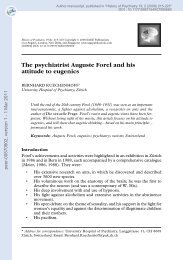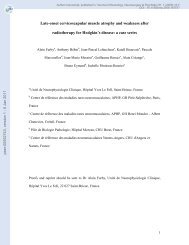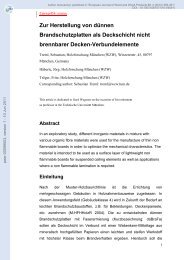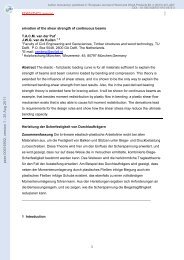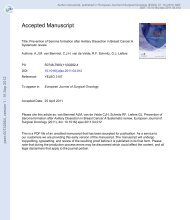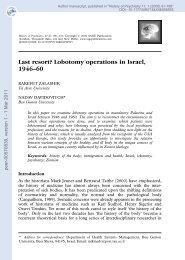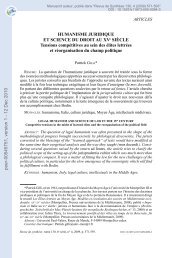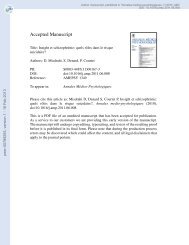Cosheaves and connectedness in formal topology
Cosheaves and connectedness in formal topology
Cosheaves and connectedness in formal topology
You also want an ePaper? Increase the reach of your titles
YUMPU automatically turns print PDFs into web optimized ePapers that Google loves.
calculate it we pull back θ along π 0 : 1 → MX. Consider, on top of the column<br />
of squares <strong>in</strong> the diagram, a further pullback square got by pull<strong>in</strong>g back along<br />
π 0 : 1 → MX. S<strong>in</strong>ce π 0 ; ! MX = Id 1 , the vertex of the pullback square must be<br />
homeomorphic to CS(X; π 0 ), so we can take the square to be of the form<br />
CS(X; π 0 )<br />
!<br />
→ 1<br />
↓ p ′′ ↓ π 0<br />
CS MX (X; (!; π 0 ))<br />
q<br />
−→<br />
′<br />
MX<br />
with p ′′ ; p ′ = Id CS(X;π0). S<strong>in</strong>ce (q ∗ π 0 ); r is a homeomorphism, there is a unique<br />
map CS(X; π 0 ) → CS(X; π 0 ) over X ×1, <strong>and</strong> so a unique homorphism π 0 → π 0<br />
which must be the identity.<br />
peer-00821313, version 1 - 9 May 2013<br />
8. Conclusions<br />
As far as I am aware, <strong>connectedness</strong> <strong>and</strong> local <strong>connectedness</strong> have not been<br />
<strong>formal</strong>ized <strong>in</strong> full generality for <strong>formal</strong> topologies (not necessarily overt). On<br />
the other h<strong>and</strong>, <strong>in</strong> topos theory they have been extensively studied <strong>in</strong> great<br />
generality, be<strong>in</strong>g applied not only to locales (as the ord<strong>in</strong>ary topos-theoretic<br />
notion of topological space) but also to toposes (as generalized spaces) <strong>and</strong> to<br />
geometric morphisms (as spaces relative to other spaces). The topos theory also<br />
l<strong>in</strong>ks these notions to that of cosheaf, <strong>and</strong> studies the space of cosheaves (the<br />
symmetric topos) <strong>and</strong> cosheaves as maps (the complete spreads) analogous to<br />
local homeomorphisms.<br />
Much of the content of the present paper has been just to transfer a small<br />
part of this topos theory to <strong>formal</strong> <strong>topology</strong>. Where it deals with <strong>in</strong>ductively<br />
generated <strong>formal</strong> topologies, it can be understood as translat<strong>in</strong>g the topostheoretic<br />
use of sites. Nonetheless, we have shown that there is much predicative<br />
content <strong>in</strong> a body of topos theory that is generally conducted impredicatively.<br />
Our ma<strong>in</strong> orig<strong>in</strong>al contributions are as follows.<br />
First, we have imported the technology of cosheaves <strong>in</strong>to <strong>formal</strong> <strong>topology</strong>.<br />
In the <strong>in</strong>ductively generated case the def<strong>in</strong>ition is predicative (no quantification<br />
over subsets) <strong>and</strong> we have also imported the associated technology of complete<br />
spreads.<br />
Second, we have given general def<strong>in</strong>itions of <strong>connectedness</strong> <strong>and</strong> local <strong>connectedness</strong><br />
for <strong>formal</strong> <strong>topology</strong>. That of <strong>connectedness</strong> extends known def<strong>in</strong>itions<br />
for the overt case, but is not predicative. For local <strong>connectedness</strong> we have used<br />
cosheaves to give a def<strong>in</strong>ition that (i) works with arbitrary bases, rather than<br />
requir<strong>in</strong>g a special base of connected opens, <strong>and</strong> (ii) <strong>in</strong> the <strong>in</strong>ductively generated<br />
case is predicative.<br />
Third, we have presented a new approach to a particular result from topos<br />
theory, that X is locally connected iff MX is totally connected (i.e. has a<br />
strongly term<strong>in</strong>al po<strong>in</strong>t). Our new proof is aimed at be<strong>in</strong>g predicative, <strong>and</strong><br />
suggests a notion of “<strong>formal</strong> topos”, such as MX, as “generalized <strong>formal</strong> <strong>topology</strong>”.<br />
Thus we have sketched a glimpse of “<strong>formal</strong> topos theory”.<br />
31



